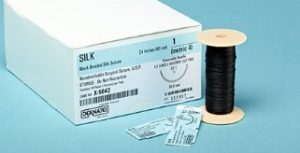Silk is a natural non-absorbable suture material that has been widely used for wound ligation; it was the most common natural suture, surpassing collagen, used in the biomedical industry during the past 100 years. Silk sutures are entwined thread from silk worm larva. Silk sutures are coated and braided non-absorbable sutures. Silk sutures are specially treated with silicone to give strength and smoothen the surface which provides easy passage through tissues. Silk sutures are widely used as ligature and are also used for other applications like skin, ophthalmic, GI tract, etc. and are not indicated for use in biliary and urinary tract surgery. Silk sutures have moderate tissue reaction.

Related project:- Black Braided Silk Sutures (Non Absorbable Surgical Suture)
The ideal suture material is sterile, easy to handle, strong (along all of its length), resistant to infection and cheap. It also has to behave in the way we want it to, in a consistent manner. As you might imagine, it is extremely difficult to manufacture the ‘perfect’ suture, which is why there is a wide variety of materials available which offer unique characteristics.
Demand of Silk Sutures
The category of suture used depends on the type of surgery, nature of the location, and the preference and professional understanding of the surgeon. A variety of sutures, with varied properties are available according to the usage. Sutures can be widely categorized into two types: non-absorbable sutures and absorbable sutures. An absorbable suture dissolves in tissue after a certain time period. It degenerates as the wound or incision cures. A non-absorbable suture does not dissolve in the body and has to be removed by a surgeon after a surface incision has healed. An ideal suture should be strong, non-toxic, hypoallergenic, and flexible. In addition, sutures should not absorb fluid to avoid unwanted infection.
Based on type, the global absorbable sutures market can be segmented into monofilament sutures and multifilament or braided sutures. Monofilament sutures have easy passage through the tissues, whereas multifilament sutures have stable knotting feature. In general, monofilament sutures produce less tissue reaction compared to multifilament sutures. Multifilament sutures are mostly braided and layered with various materials such as silicon, polycaprolactone, wax, calcium stearate, PTFE, etc.
Market Analysis of the Silk Sutures Industry
Sutures currently account for the largest share of the total market and is expected to grow at a CAGR of 5.6% from 2018 to 2024. Automated suturing devices are cited as the major trend driving the growth of surgical sutures market. Demand for automated suturing device is increasing due to an increase in number of surgeries performed in the hospitals and ambulatory surgical centers, rising demand for minimally invasive surgeries, lower injury risk to surgeons, reduced suturing time, and greater focus on prevention of hospital acquired infections.
Cardiovascular surgeries accounted for the largest share and is expected to witness the highest CAGR of 5.8% during the projected period. The largest share and fastest CAGR of this segment is mainly attributed to the growing aging population and prevalence of cardiovascular diseases, and rising Coronary Artery Bypass Graft (CABG) cases across the globe.
Hospitals are the largest end users of surgical sutures attributed to the increasing number of complex surgeries performed in the hospitals, rising geriatric population and surgeries, favorable reimbursement policies for hospital treatments, and increasing number of private hospitals especially in emerging countries.
Related videos:- Disposable Products
Conclusion
“Silk Sutures” is the project report by NPCS the scope of all the project report includes assessing market potential, negotiating with collaborators, investment decision making, corporate diversification planning, etc. in a very planned manner by formulating detailed manufacturing techniques and forecasting financial aspects by estimating the cost of raw material. Many of the engineers, project consultant & industrial consultancy firms in India and worldwide use our project reports as one of the input in doing their analysis.
| Noo_Art2021 |